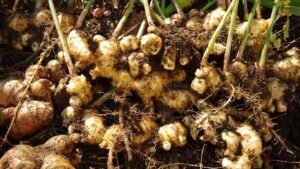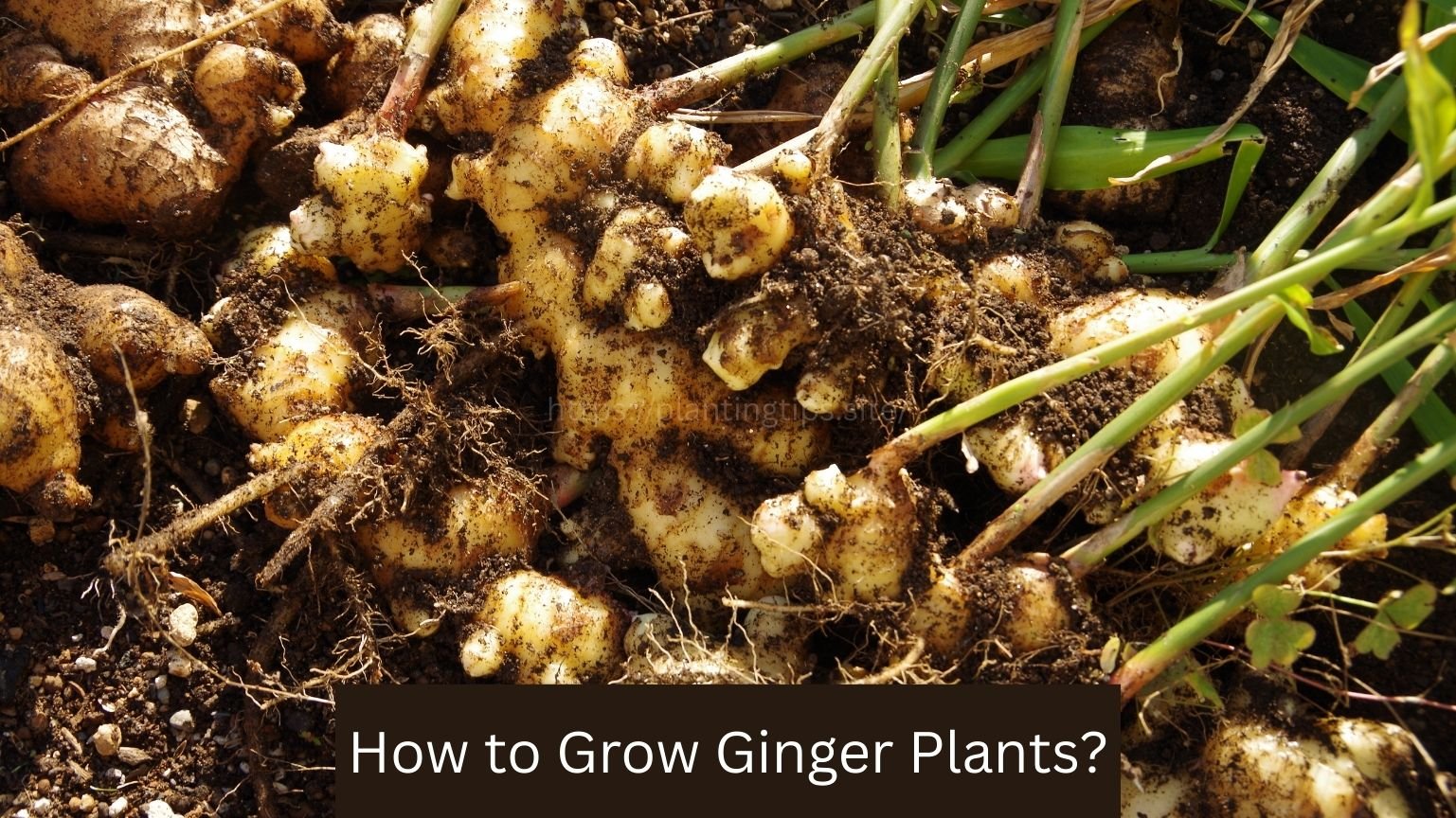Ginger is one of the most versatile plants around, widely used in cooking, medicine, and even cosmetics. If you’ve ever wondered, “How do I grow ginger plants?”, you’re in the right place! In this guide, we’ll explore everything you need to know about growing ginger at home, from planting techniques to harvesting methods. Whether you’re a seasoned gardener or just starting, you’ll find helpful tips to cultivate this unique and beneficial plant successfully.
What is Ginger and Why Should You Grow It?
Before diving into the “how,” let’s start with the “why.” Ginger (Zingiber officinale) is a tropical plant known for its aromatic rhizomes (roots), which are used in countless recipes, teas, and natural remedies. It’s a great addition to any home garden, and the best part is that it thrives indoors and outdoors under the right conditions.
Growing ginger in your own garden means you can enjoy fresh ginger year-round, without needing to buy it from the store. Fresh ginger has a much stronger flavor and more nutrients than the dried variety. Plus, growing your own ginger plant is relatively simple and can be a rewarding experience.
Ideal Conditions for Growing Ginger
Ginger plants need specific conditions to grow successfully. Here’s what you need to create the perfect environment for your ginger plant.
Climate and Temperature
Ginger thrives in warm, humid climates with temperatures between 70°F to 85°F (21°C to 29°C). If you live in a cooler region, don’t worry – you can still grow ginger indoors, where you can control the temperature.
Soil
Ginger prefers rich, well-draining soil that is slightly acidic. A soil pH between 5.5 and 6.5 is ideal. You can enhance your soil by mixing compost or organic matter to improve texture and drainage.
Light
While ginger loves warmth, it doesn’t require direct sunlight all day. It thrives in partial shade or filtered light. If you’re growing ginger indoors, a spot near a window with indirect sunlight works well.
Step-by-Step Guide: How to Plant Ginger
Now that you know the ideal growing conditions, let’s move on to planting your ginger. Here’s a step-by-step breakdown to help you start your ginger-growing journey.
1. Choosing Ginger Rhizomes
To start growing ginger, you’ll need to find healthy ginger rhizomes. Look for plump rhizomes with well-defined eyes (the small buds from which shoots grow). You can find ginger rhizomes at garden centers or even grocery stores. Organic ginger is a good option since it hasn’t been treated with growth inhibitors.
2. Preparing the Rhizomes
Before planting, soak the ginger rhizomes in water for 1-2 hours to encourage sprouting. Cut the rhizomes into small pieces with at least one eye on each piece. Allow the pieces to dry for 24 hours before planting to reduce the risk of rotting.
3. Planting the Ginger
Plant the rhizomes in a container or directly in the ground, depending on your growing space. For containers, use a deep pot (at least 10 inches deep) with good drainage. Place the ginger rhizomes 2-4 inches beneath the soil surface, with the eyes facing up.
4. Watering
Water the ginger thoroughly after planting, but avoid overwatering. Ginger prefers moist soil, but too much water can cause root rot. Keep the soil consistently moist, especially during the warm growing season.
5. Mulching
Mulch around the plant with straw or leaves to retain moisture and maintain a stable temperature for the roots. This is especially important if you’re growing ginger outdoors in a warmer climate.
Caring for Your Ginger Plant
Once your ginger is planted, it’s time to care for it. Proper maintenance is key to healthy growth.
1. Watering Schedule
Ginger plants need plenty of water, but be careful not to saturate the soil. Water your ginger whenever the top inch of soil feels dry. However, during the cooler months, reduce watering to avoid root rot.
2. Fertilizing
Ginger plants benefit from regular feeding. Use a balanced, organic fertilizer once a month to support growth. You can also use compost to enrich the soil.
3. Humidity and Temperature Control
Since ginger is a tropical plant, it enjoys high humidity levels. If you’re growing ginger indoors, consider using a humidifier to keep the air moist. Outdoors, consider placing the plant in a location that gets partial shade and protection from the wind.
4. Pest and Disease Management
While ginger is generally pest-resistant, watch out for common garden pests like aphids or root rot. If you spot pests, use organic insecticidal soap or neem oil to treat them.
Harvesting Ginger
The time it takes for ginger to mature depends on growing conditions and the variety. On average, ginger is ready for harvest after 8-10 months. However, if you prefer younger, milder ginger, you can begin harvesting after 4-6 months.
1. Signs of Maturity
Look for yellowing leaves and the plant starting to wither. This indicates that the rhizomes are mature and ready for harvesting.
2. How to Harvest
To harvest, gently dig around the base of the plant with a garden fork or shovel. Pull out the rhizomes carefully, ensuring you don’t damage the roots. You can either harvest the entire plant or just take a portion of the rhizomes and leave the rest to continue growing.
3. Storing Ginger
Freshly harvested ginger can be used immediately, or you can store it in the refrigerator for a few weeks. For long-term storage, dry the rhizomes and keep them in an airtight container.
Medicinal Uses of Ginger
Ginger is not just a flavorful ingredient – it has numerous medicinal benefits. Here are a few uses:
- Digestive Aid: Ginger is known for its ability to help with nausea, indigestion, and upset stomachs. It’s often used in teas or as a supplement for digestive health.
- Anti-Inflammatory: The active compound in ginger, called gingerol, has anti-inflammatory properties, making it beneficial for people with arthritis or muscle pain.
Cold and Flu Remedy: Ginger can help with sore throats and congestion. Drinking ginger tea is a popular home remedy to alleviate symptoms of a cold or flu.
Growing Ginger Indoors vs. Outdoors

Growing Ginger Indoors
If you live in a colder climate, growing ginger indoors is a great option. Choose a large container with drainage holes and place it in a spot with indirect sunlight. Maintain the indoor temperature between 70°F and 85°F, and keep the humidity levels high by misting the plant regularly.
Growing Ginger Outdoors
Ginger grows best outdoors in tropical or subtropical climates. It needs plenty of space to spread, so plant it in an area that receives partial sunlight and has well-draining soil. During the winter months, protect it from frost by covering it with mulch or moving it indoors if necessary.
Seasonal Guide for Growing Ginger
Here’s a seasonal breakdown for optimal ginger planting and care:
- Spring: Plant your ginger rhizomes in early spring when the temperatures begin to warm. This is the best time to establish your ginger plant.
- Summer: Maintain regular watering and fertilization. Ensure the plant is receiving enough sunlight and protection from extreme heat.
- Fall: As temperatures cool, reduce watering slightly and prepare your plant for harvest.
Winter: If grown outdoors, mulch ginger heavily to protect it from frost. Indoors, reduce watering and ensure the plant is not exposed to cold drafts.
FAQs
- Can I grow ginger from store-bought rhizomes?
Yes, you can grow ginger from rhizomes purchased at the store, as long as they are organic and have visible eyes for sprouting. - How often should I water my ginger plant?
Water ginger whenever the top inch of soil feels dry, but avoid letting the plant sit in water to prevent root rot. - How do I know when my ginger is ready to harvest?
Ginger is ready for harvest when the leaves start turning yellow and the plant begins to wither. This typically takes 8-10 months. - Can ginger grow in pots?
Yes, ginger can be successfully grown in containers. Ensure the pot is deep enough (at least 10 inches) to allow the rhizomes to grow properly. - What are the best conditions for growing ginger indoors?
Indoors, ginger needs a warm environment (70°F to 85°F), indirect sunlight, and high humidity. A humidifier can help create the right conditions.

